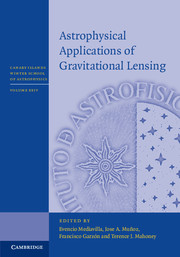Book contents
- Frontmatter
- Contents
- List of contributors
- List of participants
- Preface
- Acknowledgements
- 1 Lensing basics
- 2 Exoplanet microlensing
- 3 Four case studies of microlensing
- 4 Gravitational (micro)lensing of quasars and AGN
- 5 Dark matter in clusters and large-scale structure
- 6 The future of strong lensing
- 7 Methods for strong lens modelling
- 8 Tutorial on inverse ray shooting
- References
5 - Dark matter in clusters and large-scale structure
Published online by Cambridge University Press: 05 September 2016
- Frontmatter
- Contents
- List of contributors
- List of participants
- Preface
- Acknowledgements
- 1 Lensing basics
- 2 Exoplanet microlensing
- 3 Four case studies of microlensing
- 4 Gravitational (micro)lensing of quasars and AGN
- 5 Dark matter in clusters and large-scale structure
- 6 The future of strong lensing
- 7 Methods for strong lens modelling
- 8 Tutorial on inverse ray shooting
- References
Summary
Gravitational lensing offers a unique tool to study dark matter on a broad range of scales, from galaxies to clusters, to the large-scale matter distribution in the Universe. Density fluctuations on large scales have a small amplitude, hence their lensing effects are weak. In this chapter, after introducing the concepts of weak gravitational lensing – which are quite different from those used in strong lensing – I will concentrate on three main topics: the mass distribution of galaxy clusters as obtained from combining strong and weak lensing results, the lensing effects of the large-scale matter distribution in the Universe and lessons to be learned from them, and the weak lensing studies of the mass profiles in the outskirts of galaxies, together with the correlation of galaxies and the underlying dark matter distribution.
Introduction
Since gravitational light deflection is independent of the nature and state of matter, and in particular is equally sensitive to luminous and dark matter, it provides a unique tool for studying the total mass distribution of objects in the Universe. The study of the mass properties in the inner part of galaxies is covered by other chapters in this volume, as well as that of stellar- and planetary-mass objects. In my chapter, the mass distribution on larger scales is treated, namely that of galaxy clusters (Section 5.3), the statistical properties of the mass of galaxies, groups and clusters on large scales (Section 5.5), and that of the large-scale structure in the Universe in Section 5.4.
In preparing this chapter, I have assumed that the reader has read the contribution by Sherry Suyu (Chapter 1, this volume), where the basic theory of gravitational lensing is treated thoroughly, or is otherwise familiar with the concepts of gravitational lensing. Furthermore, I assume a certain familiarity with the cosmological standard model. It should also be mentioned here that I have written about these topics before, with extended lecture notes published as Schneider (2006). For more details on many issues discussed below, I refer the reader to this work. For the same reason, only a few papers from before 2005 are cited. I have made no efforts to present a balanced, or even complete presentation of the subject; therefore, I apologize to all those colleagues whose work has not been discussed or cited.
- Type
- Chapter
- Information
- Astrophysical Applications of Gravitational Lensing , pp. 141 - 182Publisher: Cambridge University PressPrint publication year: 2016

